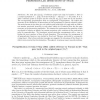Free Online Productivity Tools
i2Speak
i2Symbol
i2OCR
iTex2Img
iWeb2Print
iWeb2Shot
i2Type
iPdf2Split
iPdf2Merge
i2Bopomofo
i2Arabic
i2Style
i2Image
i2PDF
iLatex2Rtf
Sci2ools
DCG
2002
2002
Perpendicular Dissections of Space
For each pair (Qi, Qj) of reference points and each real number r there is a unique hyperplane h QiQj such that d(P, Qi)2 - d(P, Qj)2 = r for points P in h. Take n reference points in d-space and for each pair (Qi, Qj) a finite set of real numbers. The corresponding perpendiculars form an arrangement of hyperplanes. We explore the structure of the semilattice of intersections of the hyperplanes for generic reference points. The main theorem is that there is a real, additive gain graph (this is a graph with an additive real number associated invertibly to each edge) whose set of balanced flats has the same structure as the intersection semilattice. We examine the requirements for genericity, which are related to behavior at infinity but remain mysterious; also, variations in the construction rules for perpendiculars. We investigate several particular arrangements with a view to finding the exact numbers of faces of each dimension. The prototype, the arrangement of all perpendicular bis...
| Added | 18 Dec 2010 |
| Updated | 18 Dec 2010 |
| Type | Journal |
| Year | 2002 |
| Where | DCG |
| Authors | Thomas Zaslavsky |
Comments (0)

